Melbourne Sculptures, Monuments and Street Art

There is a wonderful array of public sculptures, monuments and street art within and around the Melbourne area. The public art within the Central Business District includes:
Three Businessmen Who Brought Their Own Lunch: Batman, Swanston And Hoddle
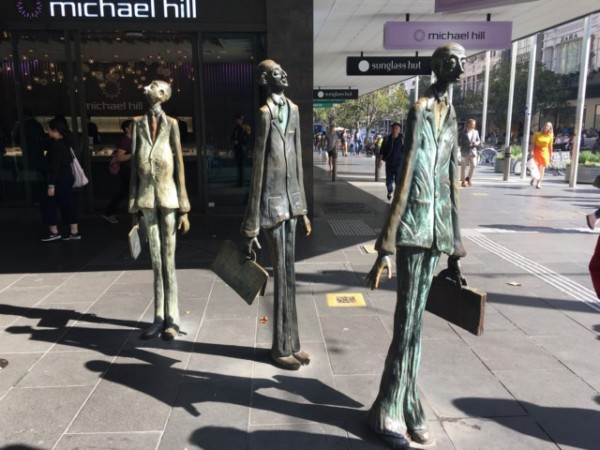
by Alison Weaver and Paul Quinn (1993)
This whimsical, life-size bronze sculpture of three businessmen carrying lunchboxes is located in the heart of Melbourne. Artist Alison Weaver claims that while the men are named and motionless, they are also intended to be anonymous and to represent being 'trapped in the perpetual motion of consumerism'. Weaver figures these three Melbourne pioneers as 'pedestrians of vast time' who have returned to the city streets, and says her interpretation of them is driven by humour rather than by iconoclasm.
Location: Corner of Swanston Street and Bourke Street (south west side).
A History Apparatus - Vessel Craft and Beacon
by Chris Reynolds (1993)
The artwork was conceived as part of the National Metal Industry Sculpture Project, an innovative sculpture-in-residency program that aimed to cultivate links between the artistic and technical endeavours and the greater community.
The work comprises three main elements - the vessel, craft and beacon - and three lesser elements - the chord, snip-ring and trestle. The main components of this sprawling sculpture, 24 metres in length, refer to the temporal concepts that anchor us in the world: the vessel represents the past, the craft represents the present and the beacon the future.
The sculpture sits on the site of Melbourne's first underground public toilet, opened in 1902, which is listed on the Victorian Heritage Register (and is now closed).
Location: Corner of Bourke Street and Russell Street.
Ceremony and Vehicle for Conveying Spirit
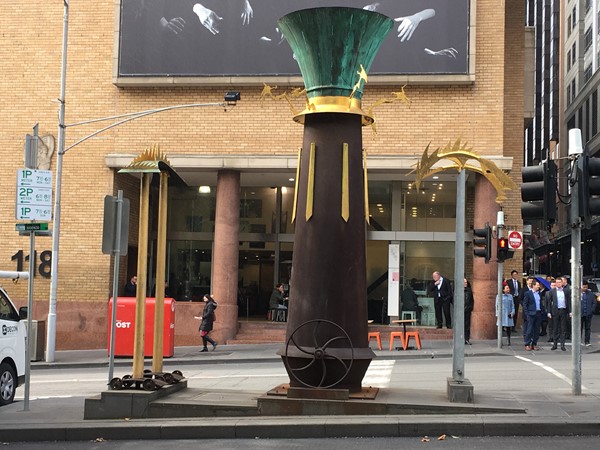
by Maurie Hughes (1996)
This monumental sculpture by Melbourne artist Maurie Hughes has been designed to take advantage of the movement of traffic and pedestrians. The use of staggered plinths explores the concept of 'journey' and the pomp of ceremonial processions. The work also references Chris Reynolds' A History Apparatus, which is located on the same median strip on the corner of Bourke Street. The idea of 'spirit' is conveyed symbolically in the flue, through which forces trapped under the earth can be released into the air. This element of the complex sculpture, with its urn, archways and sentinels, is central to the commission.
Funded by Telstra and the City of Melbourne's Urban and Public Art Program, the sculpture is linked to the redevelopment of Telstra's former Russell Street exchange. The site incorporates the ventilation point for the 6.5 kilometres of decommissioned Telstra tunnels that run beneath Melbourne's CBD and which housed the line network. Hughes' sculptural vent was commissioned with a brief to incorporate the functional and visually meaningful elements of the vent.
Location: Corner of Russell Street and Little Collins Street.
Resting Place
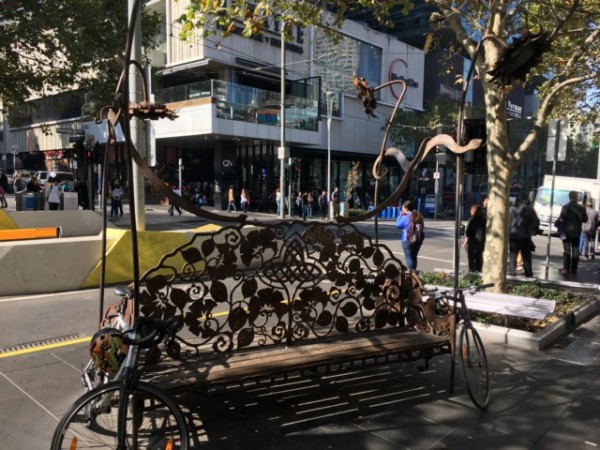
by Bronwyn Snow (1994)
Resting Place is a steel and jarrah seat sculpture that combines aesthetics and function. The double-sided seat of steel and jarrah provides a place to rest and take in the surroundings. The decorative elements of the seat include two serpents - traditionally a symbol of healing, rebirth and female power-towering sunflowers, which watch over the seated, and ivy. The artist Bronwyn Snow claims of the work that it is 'a stopping point, a resting place for the weary spiritual traveller'.
Location: Corner of Swanston Street and Little Lonsdale Street.
Time And Tide
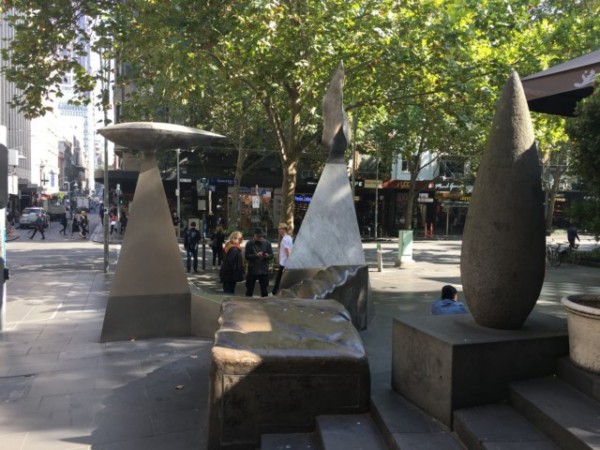
By Akio Makigawa (1994)
Like many of Makigawa's works, this bluestone, white marble bronze and stainless-steel sculpture is monumental in scale. It comprises horizontal and vertical elements, which extend some 20 metres over its Town Hall Plaza site. Fibre optics are embedded in the concrete and the light they emit creates a different mood night and day. The individual elements of Time and Tide loosely represent a tree (signifying growth, knowledge and the land), a flame (signifying rebirth and transcendence), and a shell (signifying the ocean).
Location: Corner of Swanston Street and Little Collins Street.
Dr Sun Yat Sen
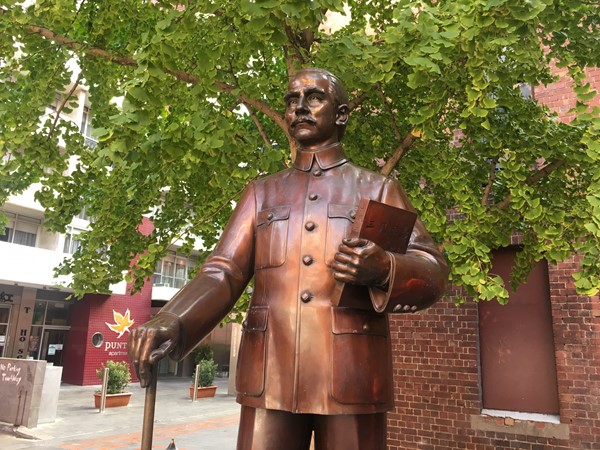
The statue commemorates Doctor Sun Yat Sen (1866 - 1925), the founder of nationalist China who played a significant role in the overthrow of the Qing Dynasty in the early 20th century.
Location: Cohen Place, Melbourne.
Tianjin Gardens Chinese Lion Guardians
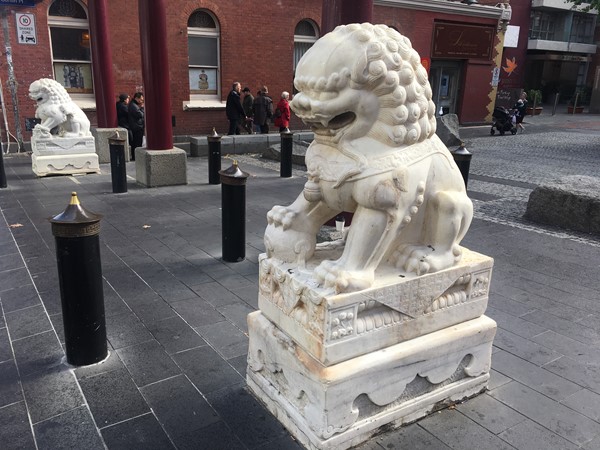
The Lions were presented as a gift from China in 1999.
Location: Cohen Place, Melbourne.
Raising the Rattler Pole - the Last of the Connies
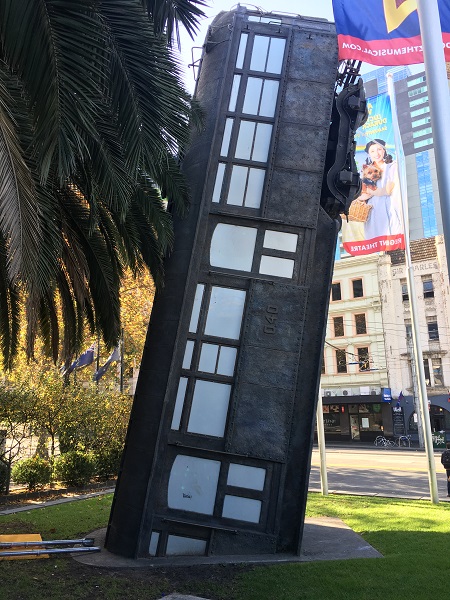
by David Michael Bell (2013)
The artwork is in the form of a 10-metre-tall, upended W-class tram which tilts at an angle of ten degrees. The artist wanted to offer a tribute to this icon tram and make a comment about the demise of the connies [conductors].
Location: Quest Grand Hotel, Cnr Spencer Street and Flinders Street.
Weather Vanes
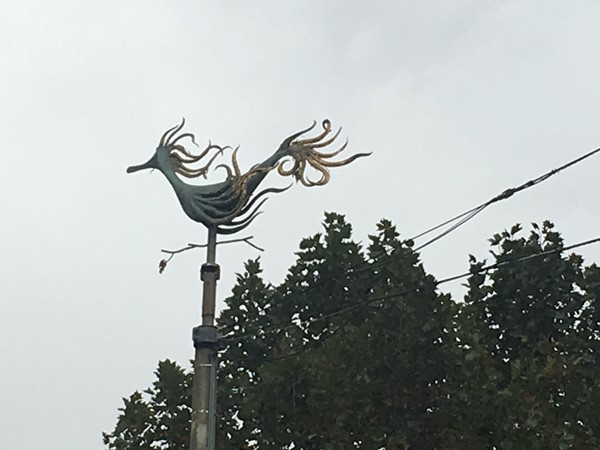
By Daniel Jenkins (1993)
Four hand-beaten copper weather vane sculptures with gold-leaf detail sitting high on tram poles above the intersection.
Each of the four weathervanes takes the shape of an animal: a horse, pig, fish and bird. They are positioned high on tram poles to give aerial performances with each gust of wind. The vanes have been conceived to represent specific aspects of Melbourne: the bird symbolises the city's parks and gardens; the horse symbolises its culture and sport; the fish refers to its waterways; and the pig represents the city's hope and future - the latter a tongue-in-cheek reference to 'pigs can fly'.
Location: Corner Bourke Street and Swanston Street.
Shadow Form III
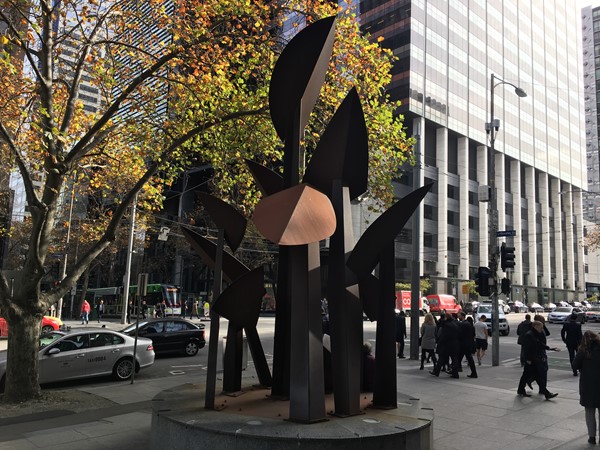
by Robert Juniper (1988)
The statue stands in front of the building which was formerly BHP House. The steel sculpture represents a clump of steel plants. The concrete plinth is a handy seat for office workers.
Location:140 William Street.
Supreme Court of Victoria Lamp post Sculptures
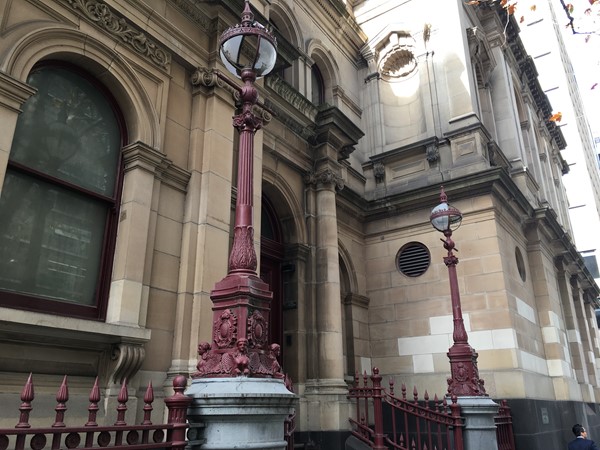 .
.Location: 210 William Street, Melbourne
The Lady of Justice (County Court)
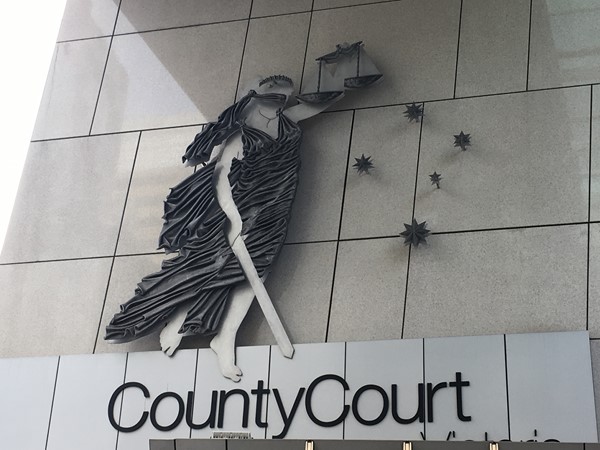
by William Eicholtz
"The Lady of Justice", is a strong, mature female figure with its combination of highly detailed drapery and smooth flat areas, evoking an image of Grecian relief sculpture. The Victorian Southern Cross at her side becomes a symbol of fairness and equality in this state.
Location: County Court Exterior, 250 William Street, Melbourne
Ngarrn-Gi - Land/Law (County Court)
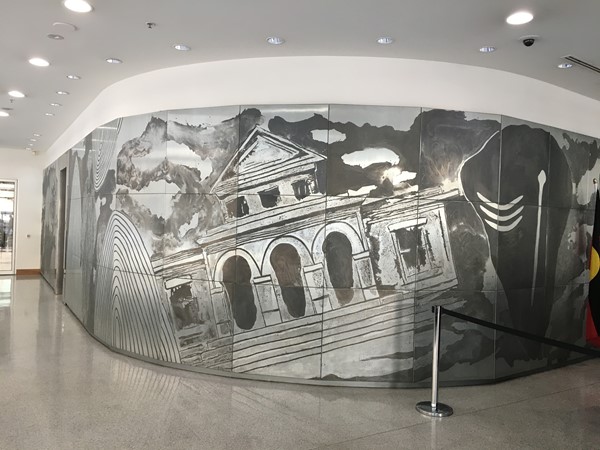
by Judy Watson
This artwork on the wall of the ground floor of the County Court has been named NGARRN-GI (to know) from the language, Woiwurrung of the Wurundjeri people.
Some of the images represented here include legal wigs, gowns, Victoria's old County Court building, ceremonial jabot and cuffs, the ground floor plans of the old law courts, law books, the County Court emblem, scales of justice, County Court stamp and Judy's own personal images. Indigenous Law in Australia predates the introduced British Common Law. Both systems of Law are strong. Aboriginal Law is inextricably linked to Land and is embodied within it.
Location: County Court Ground Floor, 250 William Street, Melbourne
Quality of Mercy (County Court)
by Colin Lanceley
The artwork comprises suspended coloured glass panels in a rectangular shape within a stainless steel frame, which exploits the natural light in the Level 1 Public Hall.
The glass is coloured and "painted" with an abstract justice theme. It is a representation of Justice as a radiant and triumphal presence facing into the Public Hall. Given the solemn mood of the mechanics of Justice, the artist wanted to create a transcendental image of Justice unencumbered; hence the broken chains and the bird image representing freedom. From the front, the Justice Figure rising from a stepped plinth has land imagery to the left and the sea to the right, the theme being justice over all.
The title is from Shakespeare's "The Merchant of Venice", which is well known to the Law.
Location: County Court, Level 1 Public Hall, 250 William Street, Melbourne
Transportation
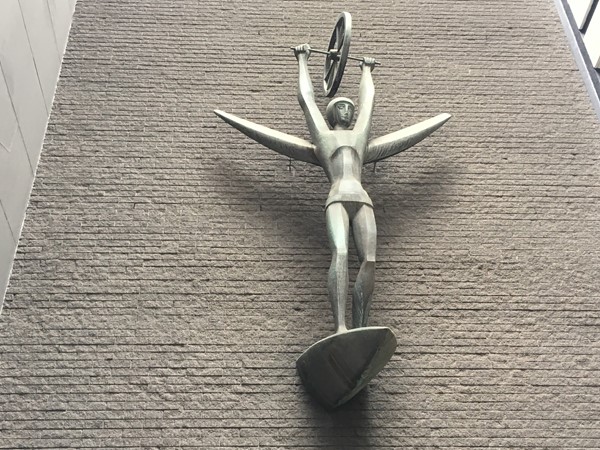
by Tom Bass (1963-64)
A figure with aeroplane wings is standing on a boat and holds aloft a wheel to possibly represent the evolution of transportation.
Location: 160 Queen Street, Melbourne.
Rhythms of the Metropolis
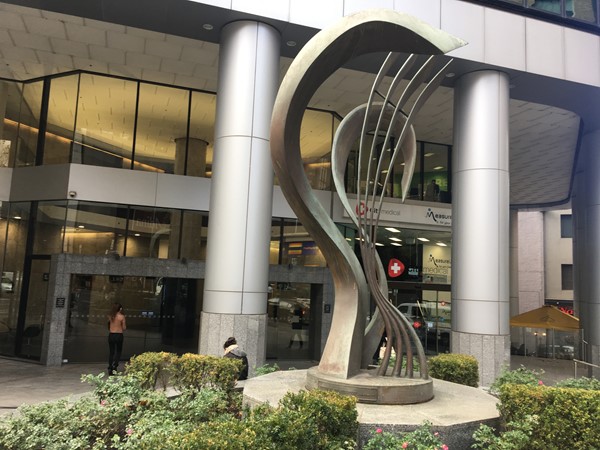
by Andrew Rogers (1996)
A large bronze sculpture which celebrates the rhythmic energy of the city.
Location: 200 Queen Street, Melbourne.
City Living
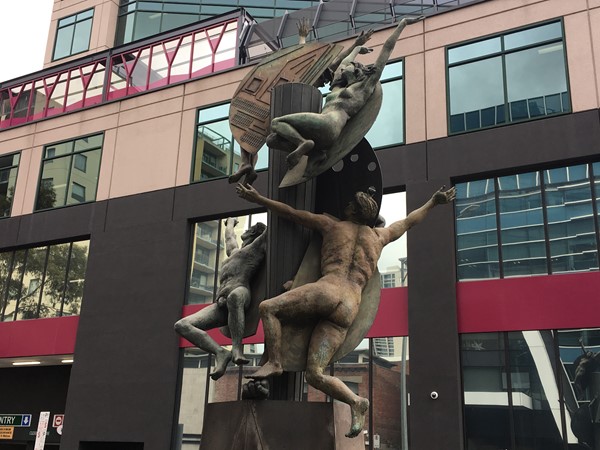
by Andrew Rogers (1996)
Has bronze figures of naked men, women and a baby escaping upwards to an abstract spirit.
Location: 28 Jeffcott Street, West Melbourne.
Red Centre
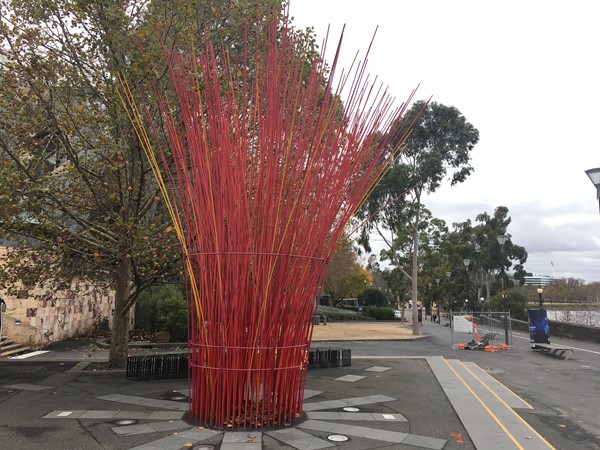
by Konstantin Dimopoulos (2006)
Red with a hint of yellow tussock of grass.
Location: Southern side of Federation Square (above the Yarra River).
Ribbon Images along Flinders Street Fence
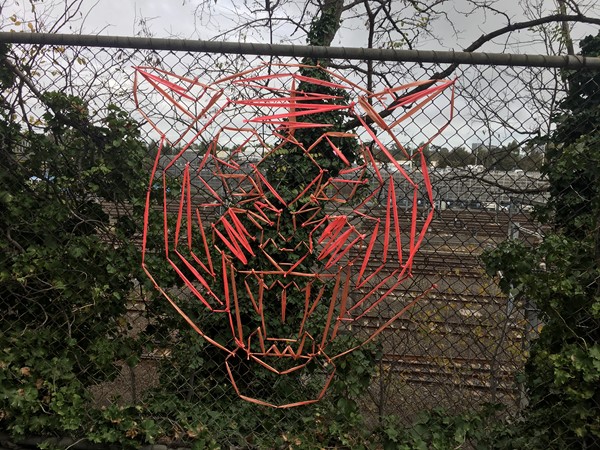
By unknown artist
A series of images created by weaving ribbon into a mesh fence.
Location: Along the fence above the Flinders Street rail tracks (opposite 106 Flinders Street, Melbourne)
Shell Mace
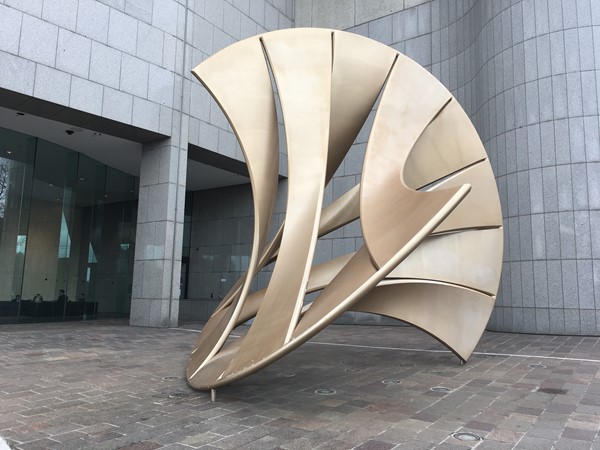
By Charles O Perry (1989)
A large metal sculpture sits in the large external plaza of the Harry Seidler-designed office tower which was formerly known as Shell House and has now been added to the Victorian Heritage Register.
Location: Corner of Flinders Street and Spring Street, Melbourne.
George Higinbotham Statue
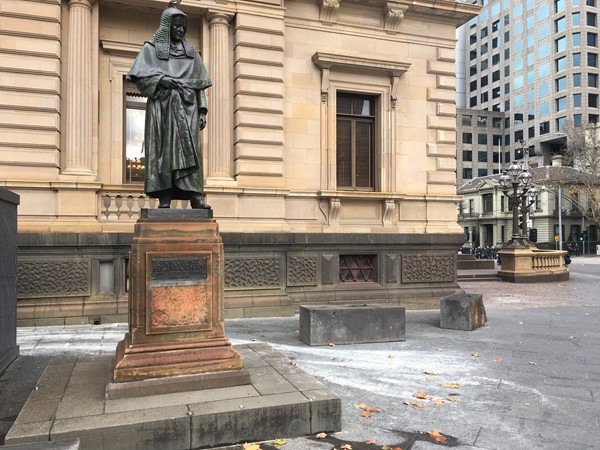
By Paul Montford (1937)
The bronze statue commemorates George Higinbotham who was the Chief Justice of Victoria from 1886 to 1892. His life was crowded with useful work, but the most interesting was his advocacy of the case for the under-dog. He was severely criticised for subscribing to the funds of the strikers in the maritime strike in the early 'nineties; but throughout he was always respected, and was universally known as "Honest George" - a title well earned.
Location: Corner Macarthur Street and Spring Street, Melbourne (outside of the Treasury Buildings)
Adam Lindsay Gordon Statue
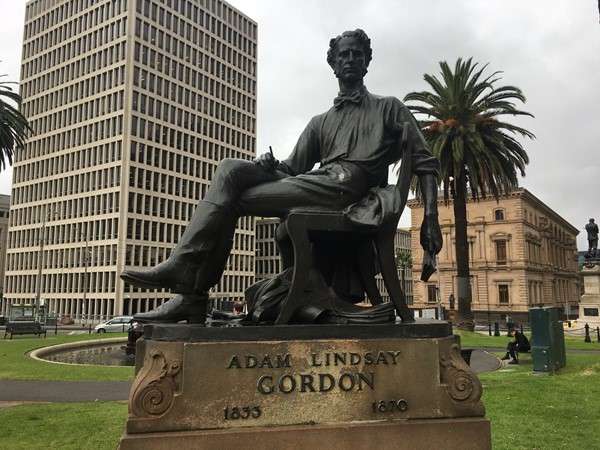
By Paul Montford
The statue, which commemorates the poet Adam Lindsay Gordon, was erected by public subscription, and combines his love of poetry (book in left hand and pencil in right) with his greater fame (he wears riding boots, breeches and shirt rolled up and under the seat is a saddle and stirrups). Gordon won the Hunt Club Cup, the Metropolitan Steeplechase and the Selling Steeplechase at Flemington all on one day in 1868. He took his own life in a fit of despair at Brighton in 1870.
Adam Lindsay Gordon (1833-1870) was born in 1833 at Fayal in the Azores where his mother's father had a plantation. He completed his education in England and was sent by his family to South Australia in 1853 where he enlisted in the mounted police. He was briefly a member of Parliament and lived in Western Australia and Ballarat before moving to Melbourne. During his time in Ballarat he suffered a severe head injury in a riding accident, was bankrupted by a fire in the livery stable and lost his infant daughter. The day after the publication of his poems in Bush Ballads and Galloping Rhymes he committed suicide on Brighton Beach in Melbourne.
Location:Gordon Reserve, 74 Spring Street, East Melbourne.
Stanford Fountain
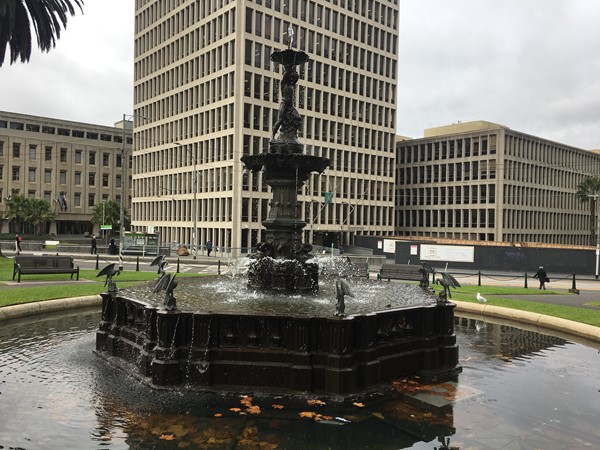
By William Stanford (c. 1870)
William Stanford's bluestone fountain features a boy on the upper tier, encircled by birds and fish on the lower tier.
Stanford was apprenticed to a London stonemason before coming to Australia to try his luck on the Bendigo goldfields. When he failed to make his fortune, he turned to horse stealing, and in 1854 was imprisoned for 10 years. He was released after six on ticket-of-leave, but was soon found guilty on two charges of highway robbery and another of horse stealing. The sentences amounted to a total of 22 years, two of which were served as hard labour in irons after Stanford broke out of a supposedly 'escape-proof' gaol in 1861. In Melbourne's Pentridge Prison, Stanford's talent for drawing and carving was recognised - he carved bones left over from stews - and the prison governor allowed him to turn his hand to carving stone. Local sculptor Charles Summers tutored Stanford, who soon set to carving a fountain from bluestone from the prison quarry, which was the only material available to him. He modelled the fountain's avian adornments on a stuffed eagle-hawk and modelled the boy on the governor's son.
The fountain was installed in Carpentaria Place (now known as Gordon Reserve) in 1871, following Stanford's release after he - and his friends petitioned for this on the grounds of his ill health. The Illustrated Australian News claimed the fountain was 'not only a work of great beauty but...executed under circumstances of extreme difficulty [which for] most men would have been insurmountable'. Stanford received no payment for the fountain but in time became a respected citizen; he established a business in Windsor, which had a reputation for creating fine headstones.
Stanford died in 1880 from 'stonemasons' disease', having inhaled a surfeit of fine dust while creating his beautiful fountain.
Location:Gordon Reserve, 74 Spring Street, East Melbourne.
General Charles Gordon Memorial
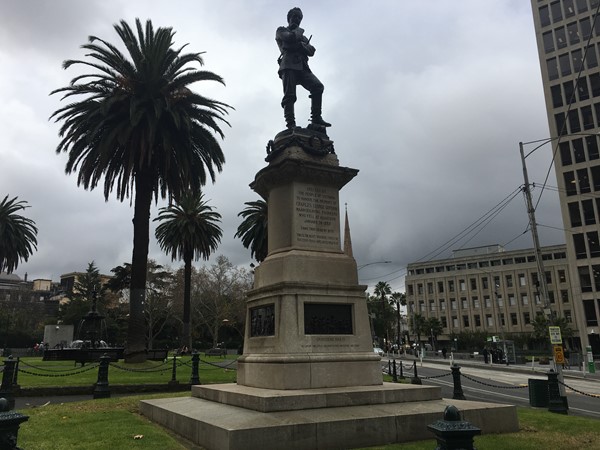
By Sculptor Hamo Thornycroft; founder J. Moore (1887)
This bronze statue depicts General Charles George Gordon holding his cane and Bible. In heroic style, the general stands over a shattered cannon, presumably to symbolise his ultimate triumph over the trials and tribulations of military victory and defeat. Four bronze bas-reliefs feature on the limestone base, each depicting one of four key stages in Gordon's life: his victories in China, his charitable activities in Gravesend, his governorship in Sudan and his death in Khartoum.
Gordon, the 'Great Christian General', was one of the most popular Englishmen of his day, and his reputation was forged on the battlefield and through his Christian activities at Gravesend. During his appointment as secretary to the viceroy of India in 1880, Gordon became unpopular with the government of the day for passionately campaigning for native rule in countries such as Botswana, South Africa and Ireland. Gordon met his death 1885 when, as governor-general of the Sudan, he refused to evacuate Egyptian forces from Khartoum, believing this to be unsafe.
Gordon's death was mourned throughout the British Empire. So great was the Australian public's response that a fund to produce a copy of Thornycroft's London monument for Melbourne was heavily oversubscribed. Perhaps due to oversubscription, Thornycroft produced the four reliefs on the limestone base, which are not found on the London statue. Although Gordon did not set foot on Australian soil, the monument is of great historical importance as his death prompted the dispatch of the first Australian troops overseas, a regiment from NSW.
Location:Gordon Reserve, 74 Spring Street, East Melbourne.
He Knew This was Going to be a Year of Good Fortune
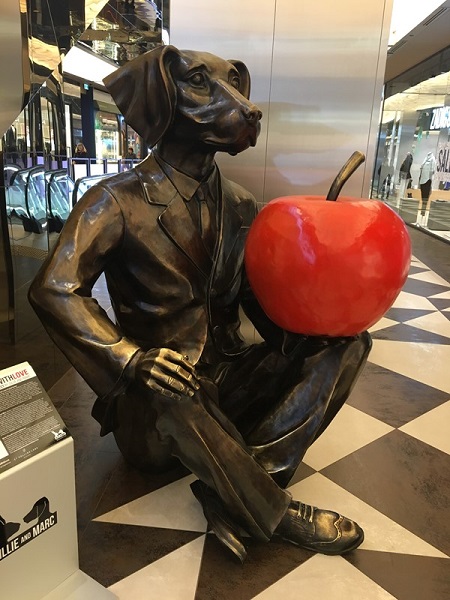
by Gillie and Marc (2018)
A 1.8 metre high sculpture of Dogman which has been created in honour of the Chinese Year of the Dog. It features Gillie and Marc's iconic Dogman character holding a giant, ruby red apple. Just as red is a lucky colour in Chinese culture, the Chinese word for apple, 'ping', sounds like the word for peace!
In Chinese tradition, when a dog enters a home it represents the coming of good fortune, Dogs are known for having harmonious relationships with people from all walks of life, and don't discriminate against socio-economic status, race, religion, or orientation. All of Gillis and Marc's art is built upon the foundation of love and togetherness. The artists created Dogman holding an apple to spread the message of diversity and acceptance for all beings, and inspire the pursuit of a better world.
Location: St. Collins Lane, Melbourne (between Maje and Zadig and Voltaire).
Guardians
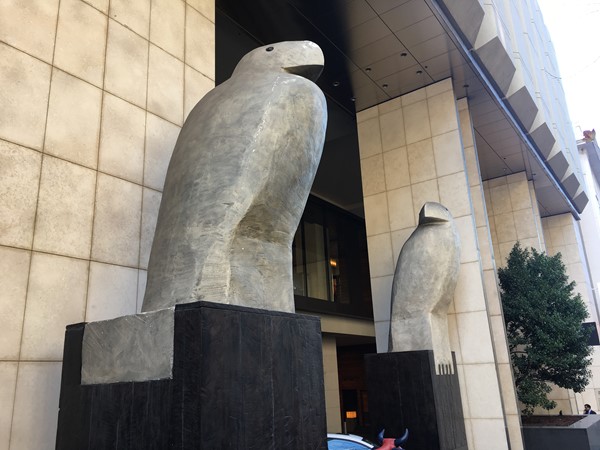
By Bruce Armstrong
Two huge eagles standing at the front of the Grand Hyatt Melbourne.
Location: Outside the Grand Hyatt Melbourne, 123 Collins Street, Melbourne
Russell Street Wall Sculpture
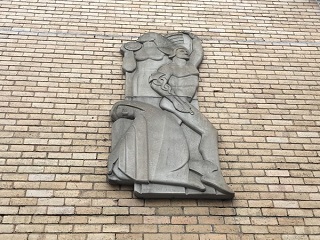
Sculpture on the exterior wall.
Location: 118 Russell Street, Melbourne
Flinders Street Station Mural
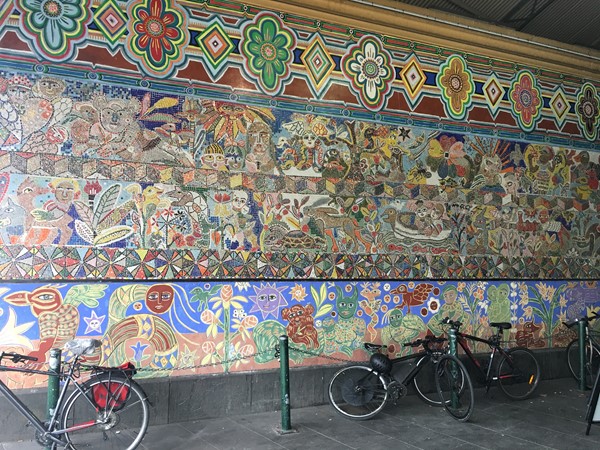
The mural is on an exterior wall of Flinders Street station.
Location: Flinders Street Station (near corner of St Kilda Road and Flinders Walk, Melbourne).
Francis Ormond Statue
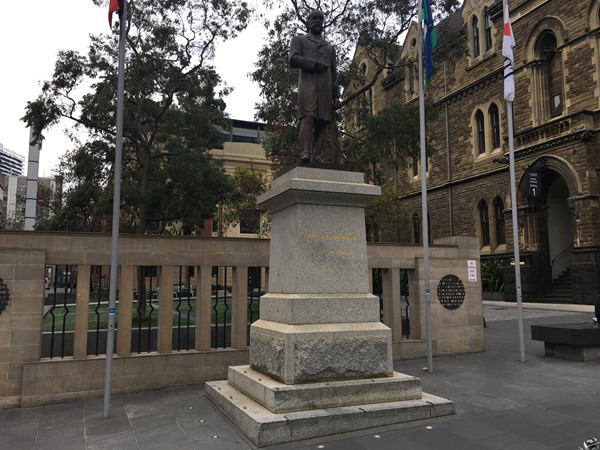
The statue commemorates Francis Ormond.
Location: RMIT City Campus, 124 La Trobe Street, Melbourne.
Hayward Lane Silhouettes of a Rainy Day
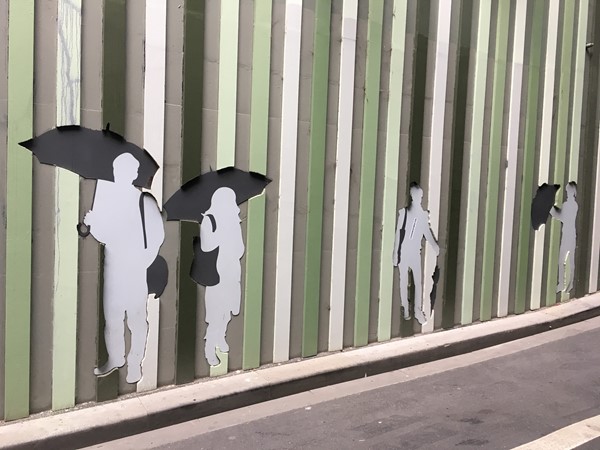
A series of silhouettes of people with umbrellas on a rainy day.
Location: On the side of a building along Hayward Lane near Latrobe Street.
Vault (Yellow Peril)
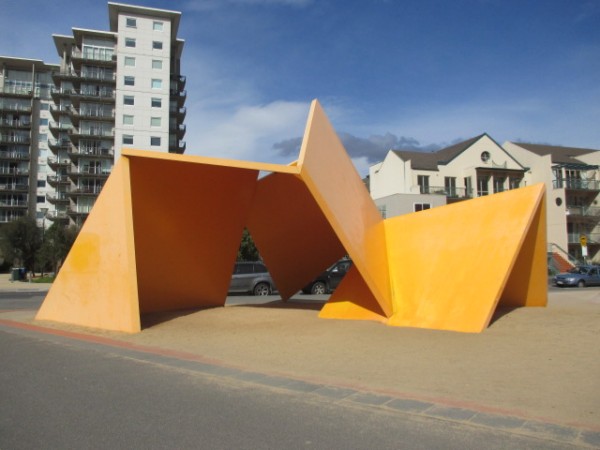
By Ron Robertson-Swann (1980)
Dubbed the 'Yellow Peril' by Councillor Osborne, the yellow, steel plate sculpture caused a storm of protest over its suitability for City Square. Ironically, it was commissioned for its compatibility with the square's design. The winner of a competition organised by the square's architects, Robertson-Swann's design met the challenge of being a 'grand interlocked sculpture'. It also met the requirement of being bold, visually simple and a strong focal point, which would offset the formal character of the square. But while Vault met these objectives, it was a little too abstract for public taste.
When the sculpture was installed it was yet to be named, and despite Robertson-Swann soon naming it Vault, Yellow Peril, with its racist overtones, has stuck.
Following its installation in 1980, Councillor Osborne tabled a survey showing Melburnians' lack of support for the sculpture's prominent position, based on the opinion that it was not sympathetic to the nearby historic St Paul's Cathedral and Town Hall. Council resolved to relocate the work, but not before it was scrawled with graffiti and used as a play structure. Despite the artist's objections, in 1981 Vault was moved to Batman Park, where among other things it served as a shelter for the homeless. In 2002, Vault was unveiled at its new home outside ACCA, where most consider it in keeping with the surrounding built environment.
Locations around the perimeter of the city with sculptures and artwork includes:
Fitzroy Gardens
Queen Victoria Gardens
State Library of Victoria Forecourt
Kings Domain
Flagstaff Gardens
Shrine of Remembrance
Queen Victoria Market
Carlton Gardens
Treasury Gardens
Some spectacular art walks are:
Docklands Public Art Walk
Yarra River Precinct Arts Walk
Heide Museum of Modern Art Sculpture Park in Bulleen (free)
McClelland Gallery & Sculpture Park in Langwarrin (free)
Montalto Vineyard Sculpture Walk in Red Hill South (free)
Point Leo Estate Sculpture Park in Merricks (fees apply)
Herring Island Environmental Sculpture Park
Most councils have a strong program of exhibiting public art. See a summary of the public art in these areas:
Boroondara Street and Public Art
Brimbank Street and Public Art
Casey Street and Public Art
Darebin Street and Public Art
Frankston Street and Public Art
Glen Eira Street and Public Art
Kingston Street and Public Art
Knox Street and Public Art
Manningham Street and Public Art
Maribyrnong Street and Public Art
Maroondah Street and Public Art
Melton Street and Public Art
Monash Street and Public Art
Mornington Peninsula Street and Public Art
Whitehorse Street and Public Art
Yarra Ranges Street and Public Art
Web Links
→ Treasury Gardens Sculptures and Monuments
→ Fitzroy Gardens Sculptures and Monuments
→ State Library of Victoria Sculptures and Monuments
→ Docklands Public Art Walk
→ Yarra River Precinct Arts Walk
→ Kings Domain Sculptures and Monuments
→ Flagstaff Gardens Sculptures and Monuments
→ Shrine of Remembrance Sculptures and Monuments
→ Queen Victoria Market Sculptures and Monuments
→ Herring Island Environmental Sculpture Park
→ Heide Museum of Modern Art Sculpture Park
→ Carlton Gardens Sculptures and Monuments
→ Queen Victoria Gardens Sculptures and Monuments









